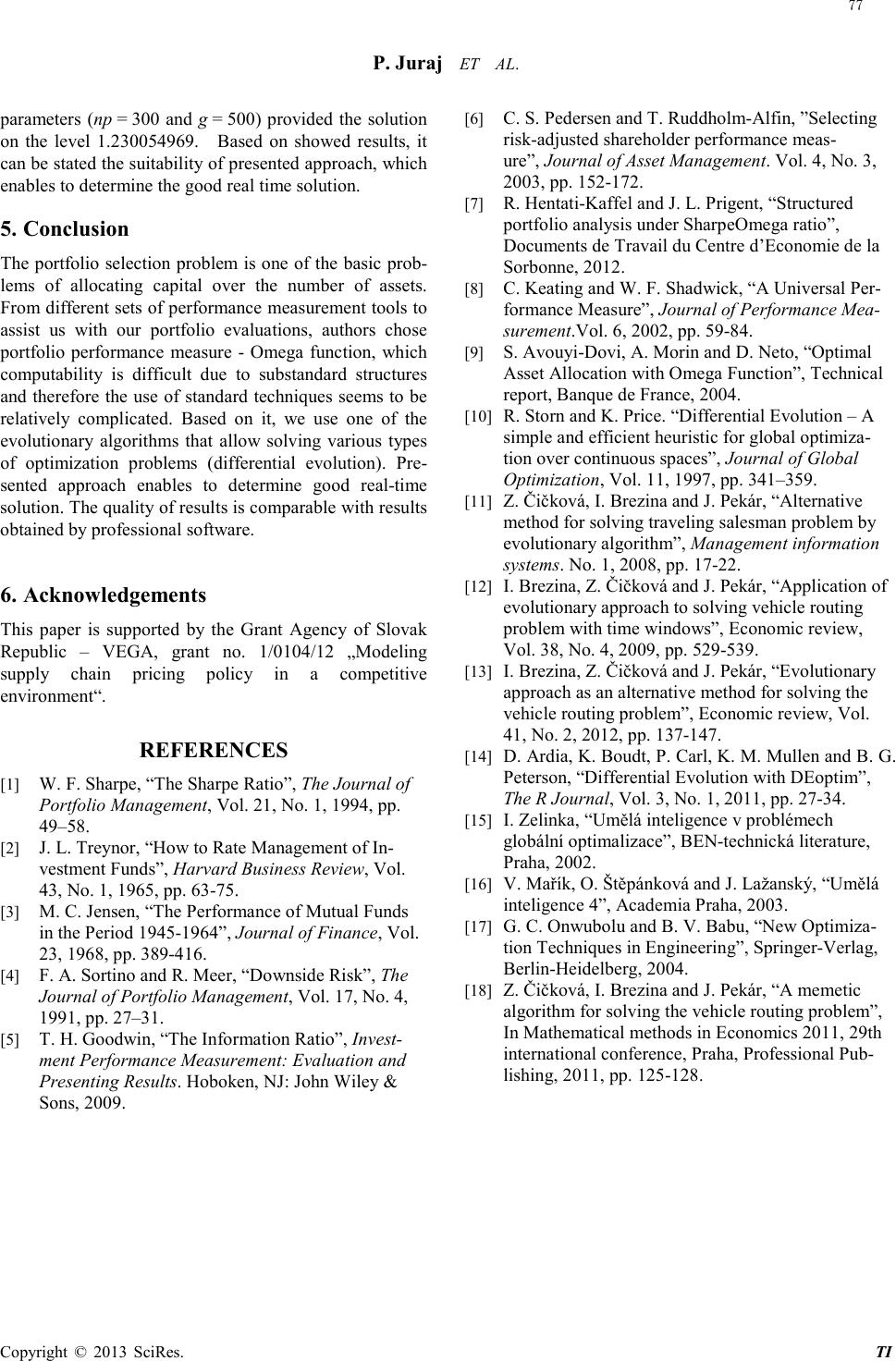
P. Juraj ET AL.
TI
parameters (np = 300 and g = 500) provided the solution
on the level 1.230054969. Based on showed resul ts, it
can be stated the suitability of presented approach, which
enables to determine the good real time solution.
5. Conclusion
The portfolio selection problem is one of the basic prob-
lems of allocating capital over the number of assets.
Fro m differ ent sets of performance measurement tools to
assist us with our portfolio evaluations, authors chose
portfolio performance measure - Omega function, which
computability is difficult due to substandard structures
and therefore the use of standard techniques seems to be
relatively complicated. Based on it, we use one of the
evolutionary algorithms that allow solving various types
of optimization problems (differential evolution). Pre-
sented approach enables to determine good real-time
solution. The quality of results is comparable with results
obtained by professional software.
6. Acknowledgements
This paper is supported by the Grant Agency of Slovak
Republic – VEGA, grant no. 1/0104/12 „Modeling
supply chain pricing policy in a competitive
environ ment“.
REFERENCES
[1] W. F. Sharp e , “The Sharpe Ratio”, The Journal of
Portfolio Management, Vol . 21, No. 1, 1994, pp.
49–58.
[2] J. L. Treyno r , “How to Rate Management of In-
vestment Funds”, Harvard Business Review, Vol.
43, No. 1, 1965, pp. 63-75.
[3] M. C. Jensen, “The Performance of Mutual Funds
in the Period 1945-1964”, Journal of Finance, Vol.
23, 1968, pp. 389-416.
[4] F. A. Sortino and R. Meer, “Downside Risk”, The
Journal of Portfolio Management, Vol. 17, No. 4,
1991, pp. 27–31.
[5] T. H. Goodwin, “The Information Ratio”, Invest-
ment Performance Measurement: Evaluation and
Presenting Results. Hoboken, NJ: John Wiley &
Sons, 2009.
[6] C. S. Pedersen and T. Ruddholm-Alfin, ”Selecting
risk-adjusted shareholder performance meas-
ure”, Journal of Asset Management. Vol. 4, No. 3,
2003, pp. 152-172.
[7] R. Hentati-Kaffe l and J. L. Prigent , “Structured
portfolio analysis under SharpeOmega ratio”,
Documents de Travail du Centre d’Economie de la
Sorbonne, 2012.
[8] C. Keating and W. F. Shadwick, “A Universal Per-
formance Measure”, Journal of Performance Mea-
sureme nt .Vol. 6, 2002, pp. 59-84.
[9] S. Avouyi-Dovi, A. Morin and D. Neto, “Optimal
Asset Allocation with Omega Function”, Technical
report, Banque de France, 2004.
[10] R. Storn and K. Price. “Differential Evolution – A
simple and efficient heuristic for global optimiza-
tion over continuous spaces”, Journal of Global
Optimization , Vol. 11, 1997, pp. 341–359.
[11] Z. Čičková, I. Brezina and J. Pekár, “Alternative
method for solving traveling salesman problem by
evolutionary algorithm”, Management information
system s. No. 1, 2008, pp. 17-22.
[12] I. Brezina, Z. Či čková a nd J. Pekár, “Application of
evolutionary approach to solving vehicle routing
problem with time windows”, Economic review,
Vol. 38, No. 4, 2009, pp. 529-539.
[13] I. Brezina, Z. Čičko vá a nd J. Pekár, “Evolutionary
approach as an alternative method for solving the
vehicle routing problem”, Economic review, Vo l.
41, No. 2, 2012, pp. 137-147.
[14] D. Ardia, K. Boudt, P. Carl, K. M. Mullen and B. G.
Peterson, “Differential Evolution with DEoptim”,
The R Journal, Vol. 3, No. 1, 2011, pp. 27-34.
[15] I. Zelinka, “Umělá inteligence v problémech
globální optimalizace”, BEN-technická literature,
Pr aha , 2002.
[16] V. Mařík, O. Štěpánková and J. Lažanský, “Umělá
inteligence 4”, Academia Praha, 2003.
[17] G. C. Onwubolu and B. V. Babu, “New Optimiza-
tion Techniques in Engineering”, Springer-Verlag,
Berlin-Heidelberg, 2004.
[18] Z. Čičková, I. Brezina and J. Pekár, “A memetic
algorithm for solving the vehicle routing problem”,
In Mathematical methods in Economics 2011, 29th
international conference, Praha, Professional Pub-
lishing, 2011, pp. 125-128.
77
Copyright © 20 SciRes.
13